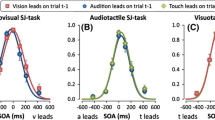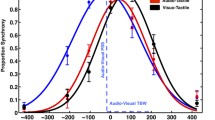Abstract
When formulating an estimate of event time, the human sensory system has been shown to possess a degree of perceptual flexibility. Specifically, the perceived relative timing of auditory and visual stimuli is, to some extent, a product of recent experience. It has been suggested that this form of sensory recalibration may be peculiar to the audiovisual domain. Here we investigate how adaptation to sensory asynchrony influences the perceived temporal order of audiovisual, audiotactile and visuotactile stimulus pairs. Our data show that a brief period of repeated exposure to asynchrony in any of these sensory pairings results in marked changes in subsequent temporal order judgments: the point of perceived simultaneity shifts toward the level of adaptation asynchrony. We find that the size and nature of this shift is very similar in all three pairings and that sensitivity to asynchrony is unaffected by the adaptation process. In light of these findings we suggest that a single supramodal mechanism may be responsible for the observed recalibration of multisensory perceived time.


Similar content being viewed by others
References
Arnold DH, Johnston A, Nishida S (2005) Timing sight and sound. Vis Res 45:1275–1284
Behar I, Bevan W (1961) The perceived duration of auditory and visual intervals: cross-modal comparison and interaction. Am J Psychol 74:17–26
Ernst MO (2007) Learning to integrate arbitrary signals from vision and touch. J Vis 7:1–14
Fain GL (2003) Sensory transduction. Sinauer Associates, Sunderland
Fujisaki W, Shimojo S, Kashino M, Nishida S (2004) Recalibration of audiovisual simultaneity. Nat Neurosci 7:773–778
Haggard P, Clark S, Kalogeras J (2002) Voluntary action and conscious awareness. Nat Neurosci 5:382–385
Harrar V, Harris LR (2005) Simultaneity constancy: detecting events with touch and vision. Exp Brain Res 166:465–473
Helson H (1964) Adaptation-level theory. Harper & Row, New York
Heron J, Whitaker D, McGraw PV, Horoshenkov KV (2007) Adaptation minimizes distance-related audiovisual delays. J Vis 7:1–8
Keetels M, Vroomen J (2007) No effect of auditory–visual spatial disparity on temporal recalibration. Exp Brain Res 182:559–565
Kopinska A, Harris LR (2004) Simultaneity constancy. Perception 33:1049–1060
Lewald J, Guski R (2004) Auditory–visual temporal integration as a function of distance: no compensation for sound-transmission time in human perception. Neurosci Lett 357:119–122
Mamassian P, Landy M, Maloney LT (2002) Bayesian modelling of visual perception. In: Rao RPN, Olshausen BA, Lewicki MS (eds) Probabilistic models of the brain: perception and neural function. MIT Press, Cambridge, pp 13–36
Miyazaki M, Yamamoto S, Uchida S, Kitazawa S (2006) Bayesian calibration of simultaneity in tactile temporal order judgment. Nat Neurosci 9:875–877
Navarra J, Soto-Faraco S, Spence C (2007) Adaptation to audiotactile asynchrony. Neurosci Lett 413:72–76
Pesavento MJ, Schlag J (2006) Transfer of learned perception of sensorimotor simultaneity. Exp Brain Res 174:435–442
Stetson C, Cui X, Montague PR, Eagleman DM (2006) Motor-sensory recalibration leads to an illusory reversal of action and sensation. Neuron 51:651–659
Stocker AA, Simoncelli EP (2005) Sensory adaptation within a Bayesian framework for perception. In: Weiss Y, Scholkopf B, Platt J (eds) Neural information processing systems (NIPS), vol 18. MIT Press, Vancouver
Sugita Y, Suzuki Y (2003) Audiovisual perception—implicit estimation of sound-arrival time. Nature 421:911–911
Taylor MM, Creelman CD (1967) PEST: efficient estimates on probability functions. J Acoust Soc Am 41:782–787
Vroomen J, Keetels M, de Gelder B, Bertelson P (2004) Recalibration of temporal order perception by exposure to audio–visual asynchrony. Cogn Brain Res 22:32–35
Zampini M, Brown T, Shore DI, Maravita A, Roder B, Spence C (2005) Audiotactile temporal order judgments. Acta Psychol 118:277–291
Acknowledgments
D.W. was supported by a Research Fellowship from The Leverhulme Trust.
Author information
Authors and Affiliations
Corresponding author
Rights and permissions
About this article
Cite this article
Hanson, J.V.M., Heron, J. & Whitaker, D. Recalibration of perceived time across sensory modalities. Exp Brain Res 185, 347–352 (2008). https://doi.org/10.1007/s00221-008-1282-3
Received:
Accepted:
Published:
Issue Date:
DOI: https://doi.org/10.1007/s00221-008-1282-3




